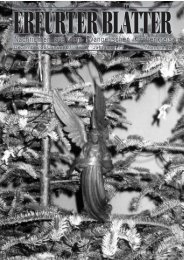08 / 09 - Evangelische Kirchen in Erfurt
08 / 09 - Evangelische Kirchen in Erfurt
08 / 09 - Evangelische Kirchen in Erfurt
Sie wollen auch ein ePaper? Erhöhen Sie die Reichweite Ihrer Titel.
YUMPU macht aus Druck-PDFs automatisch weboptimierte ePaper, die Google liebt.
1284 R. M. Alcazar, R. L<strong>in</strong> and A. Z. FireFigure 9.—Explicit test of male transmission ofsilenc<strong>in</strong>g. (A) Males dur<strong>in</strong>g copulation transmitboth sperm and sem<strong>in</strong>al fluid. The male-derivedsilenc<strong>in</strong>g efficacy can be expla<strong>in</strong>ed by at least twomodels: (1) The silenc<strong>in</strong>g factor is <strong>in</strong>side thesperm and (2) the silenc<strong>in</strong>g factor is transmittedthrough the male <strong>in</strong> the sem<strong>in</strong>al fluid. (B) Schematicof crosses designed to test the male transmissionof silenc<strong>in</strong>g through the sperm or thesem<strong>in</strong>al fluid. It was critical for this experimentthat we identify self-progeny animals that hadbeen fertilized after their parent hermaphroditehad received male sperm and sem<strong>in</strong>al fluid. Toensure this, we transferred the parent hermaphroditeseach day and scored only self-progeny thatderive from mothers that had previously producedcross-progeny. Operationally, this was carriedout by mat<strong>in</strong>g <strong>in</strong>dividual F 1 male silenc<strong>in</strong>gcarriers with five naive hermaphrodites for 6–12hr, transferr<strong>in</strong>g the hermaphrodites to <strong>in</strong>dividualfresh plates to allow egg lay<strong>in</strong>g for 1 day (firstbrood), and transferr<strong>in</strong>g hermaphrodite mothersto a second plate for an additional day (secondbrood). Of 50 mated hermaphrodites, 6 metthe criterion that they had some cross-progenyon the first day of transfer and some self-progenyon the second day of transfer. The self-progenybroods on these six plates from the second transferconsist of self- and cross-progeny that were fertilizedsubsequent to the transfer of sperm andsem<strong>in</strong>al fluid from males to the mother hermaphrodite.We then compare silenc<strong>in</strong>g transmissionto self-progeny and cross-progeny from thesebroods. The boxes summarize the viability of F 3and F 4 cross- and self-progeny from first and secondtransfers at 25°. The data show that carriermales transfer the silenc<strong>in</strong>g trait to cross-progenyand not to self-progeny. This is consistent with asignal <strong>in</strong>tr<strong>in</strong>sic to sperm and not one carried <strong>in</strong>the sem<strong>in</strong>al fluid. The asterisk <strong>in</strong>dicates that a s<strong>in</strong>gleviable F 3 larva was produced from 1 of the 36F 2 animals <strong>in</strong> this experiment; this animal yieldedno F 4 progeny and may have represented a rare‘‘spontaneous rescue’’ affect<strong>in</strong>g 1<strong>in</strong>10 4 progenyof oma-1(zu405) mothers.DISCUSSIONWe found that a s<strong>in</strong>gle dose of dsRNA target<strong>in</strong>g thegerml<strong>in</strong>e-active gene oma-1 can lead to silenc<strong>in</strong>g thatlasts multiple generations. Heritable silenc<strong>in</strong>g was<strong>in</strong>itiated by the RNAi response, with a biphasic timecourse <strong>in</strong>volv<strong>in</strong>g nearly complete but temporary suppressionof the target locus last<strong>in</strong>g three to fourgenerations, followed by a much lower frequency oflong-term silenc<strong>in</strong>g. Heritable silenc<strong>in</strong>g frequency andpersistence was dependent on the dose of <strong>in</strong>ductiontrigger. When the trigger was limited, the silenc<strong>in</strong>gefficacy was preferentially distributed <strong>in</strong> early bornprogeny. Both sperm and oocytes were capable of transmitt<strong>in</strong>gthe silenc<strong>in</strong>g signal to descendant populations.Surpris<strong>in</strong>gly, the frequency of silenc<strong>in</strong>g after spermtransmission appeared to be higher than for oocytetransmission. The silenc<strong>in</strong>g achieved by sperm transmission<strong>in</strong>volved a signal <strong>in</strong>tr<strong>in</strong>sic to sperm.Multigenerational silenc<strong>in</strong>g after RNAi treatment:Earlier analysis of heritable silenc<strong>in</strong>g <strong>in</strong> C. elegans hadbeen carried out with a number of loci. Follow<strong>in</strong>gmicro<strong>in</strong>jection of pos-1 dsRNA, one study (Grishok
















